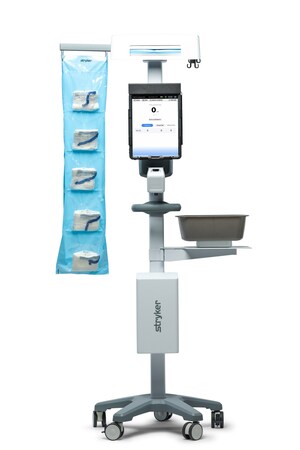Stryker's VertaPlex® HV First PMMA to Receive Clearance for Treating Sacral Insufficiency Fractures
KALAMAZOO, Mich., Oct. 15, 2015 /PRNewswire/ -- The Instruments division of Stryker Corporation announced today that its Interventional Spine business unit has received clearance from The U.S. Food and Drug Administration (FDA) to market its expanded indications of VertaPlex HV for the treatment of sacral insufficiency fractures. Stryker set a new standard in 2008 with the release of VertaPlex HV, addressing specific viscosity and working time preferences for treating vertebral compression fractures. On June 12, 2015, VertaPlex HV became the first PMMA to receive 510(k) clearance for the fixation of pathological fractures of the sacral vertebral body or ala using sacral vertebroplasty or sacroplasty.
"Careful intraoperative technique and VertaPlex HV PMMA is an excellent and safe solution in the management of sacral fractures. This new FDA approved indication will benefit countless lives," said Jeffrey W. Miller, MD, Director of Neuroendovascular Surgery at Bronson Methodist Hospital in Kalamazoo, MI, and principal investigator of the Stryker sponsored study for 510(k) submission. "I have already witnessed dramatic patient improvement in my own practice by incorporating sacral vertebroplasty/sacroplasty as part of my intraoperative protocol."
Sacral insufficiency fractures are an often under diagnosed condition in the elderly population, typically presenting with severe low back pain resulting in immobility. The diagnosis can be complicated by the fact that radiographic assessment of the sacrum is difficult and lower spine (lumbar) imaging is frequently not specifically targeted at the sacrum. Sacral vertebroplasty, a procedural extension of percutaneous vertebroplasty, involves the injection of bone cement into the sacrum with the aim of alleviating pain and facilitating more rapid mobilization than conservative therapy alone allows.
Due to the inherent porosity of sacral bone and comorbidity of osteoporosis, cement extravasation may be a risk for treatment of sacral insufficiency fractures. In this porous, osteoporotic environment, higher viscosity cement can help reduce cement spreading and forming denser cement clusters1.
"As our population ages, we will see more sacral insufficiency fractures that will require intervention," said Douglas Yim, MD, Visiting Associate Professor, Associate Program Director of Interventional Radiology at Johns Hopkins School of Medicine, Baltimore, MD. "Having a reliable and consistent high viscosity cement like VertaPlex HV will allow greater margin of safety for patients undergoing sacroplasty."
About Stryker
Stryker is one of the world's leading medical technology companies and together with our customers, we are driven to make healthcare better. The Company offers a diverse array of innovative products and services in Orthopaedics, Medical and Surgical, and Neurotechnology and Spine, which help improve patient and hospital outcomes. Stryker is active in over 100 countries around the world. Please contact us for more information at www.stryker.com.
Media Contact:
Courtney Stevens Kerry
DDM Marketing and Communications
616.632.1341
[email protected]
- Experimental Characterization of Polymethylmethacrylate Bone Cement Spreading as a Function of Viscosity, Bone Porosity, and Flow Rate Mario Loeffel, MSc, Stephen J. Ferguson, PhD, Lutz-P. Nolte, PhD, and Jens H. Kowal, PhD SPINE Volume 33, Number 12, pp 1352–1359 ©2008, Lippincott Williams & Wilkins
Products referenced with TM designation are trademarks of Stryker. Products referenced with ® designation are registered trademarks of Stryker.
1000-025-467 Rev None
SOURCE Stryker
Related Links
WANT YOUR COMPANY'S NEWS FEATURED ON PRNEWSWIRE.COM?
Newsrooms &
Influencers
Digital Media
Outlets
Journalists
Opted In





Share this article